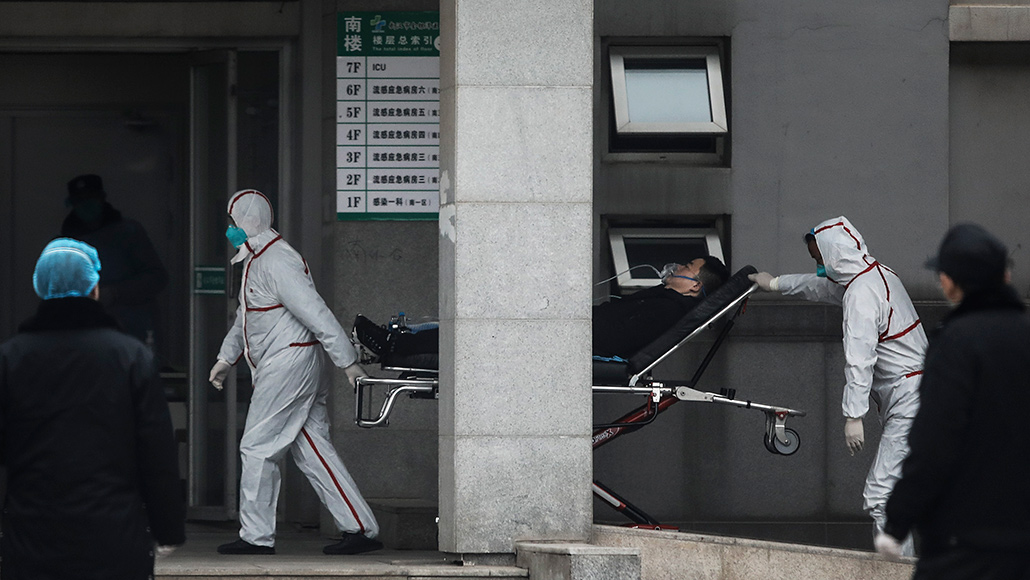The first U.S. case of a new coronavirus has been confirmed
Chinese officials say the coronavirus can spread from person to person, raising global risks

Medical staff transfer a patient to Jin Yintan hospital in the central Chinese city of Wuhan, where a new coronavirus has sparked an outbreak of pneumonia-like illness.
Getty Images/Stringer
- More than 2 years ago
A man in Seattle has been confirmed as the first U.S. case of a novel coronavirus that emerged in central China, where it has killed six people and sickened hundreds more in recent weeks, according to the U.S. Centers for Disease Control and Prevention.
Officials are also ramping up health screenings at U.S. airports, after Chinese public health officials said January 20 that the virus can spread from person to person — a factor that raises concerns of an international epidemic emerging.
It’s still unclear how easily the virus spreads between humans. The World Health Organization said it would convene an emergency committee on January 22 in Geneva to decide whether to declare a global health emergency.
“The confirmation that human-to-human spread with this virus is occurring in Asia certainly raises our level of concern,” said Nancy Messonnier, director of the CDC’s National Center for Immunization and Respiratory Diseases, during a telephone news conference on January 21. However, the agency believes the risk “to the American public at large remains low at this time.”
The Seattle patient in his 30s was diagnosed after seeing a doctor for respiratory symptoms, Messonnier said. The man had returned last week from Wuhan, and is no longer “clinically ill,” she said.
The first people reported to have the pneumonia-like illness became sick in December, after visiting a wild animal market in the central Chinese city of Wuhan. Officials soon confirmed that the outbreak was caused by a novel coronavirus (SN: 1/10/20) — the same family of viruses that causes severe acute respiratory syndrome, or SARS.
On January 20, China’s lead scientist monitoring the outbreak, Dr. Zhong Nanshan, gave a statement on Chinese state television confirming that at least two patients who had never been to Wuhan had been infected by family members who recently had traveled to the city. At least 15 health care workers are also among at least 278 cases reported by China.
Scientists are still trying to understand how dangerous the virus is. Most of the six people who died had been suffering with a preexisting health condition, says Jennifer Nuzzo, an epidemiologist at the Johns Hopkins Center for Health Security in Baltimore. And it’s unclear if the recent jump in cases is due to the virus spreading further, or simply heightened surveillance, she says.
Also unclear, she says, is how exactly the virus spreads. “Can a sick person easily transmit the disease when they’re out in the community? Or can it only be transmitted in risky situations, for example, when a health care worker is caring for a patient and their personal protective equipment fails?”
Experts also need more information about newer cases not directly tied to the Wuhan animal market, she says. Detailed patient histories can help in tracing sources of infection, but that information has yet to reach the international public health community, she says.
The severity of illness caused by the virus also is unclear, with details about the condition of patients in China yet to be shared widely, says infectious disease physician Amesh Adalja, also at Johns Hopkins Center for Health Security. “Are they requiring oxygen therapy? Intravenous fluids? Those types of questions are really important in helping us know where to place this outbreak in terms of risk,” Adalja says.
The CDC said passengers arriving on direct or connecting flights from Wuhan would be funneled through five international airports conducting health screenings — in New York City, Atlanta, Chicago, Los Angeles and San Francisco. Cases have also been reported in people who had traveled from China to Thailand, Japan and South Korea. Russian and Canadian airports are also screening some arriving passengers.
“We’re taking a proactive approach,” the CDC’s Messonnier said. “So far CDC staff have screened over 1,200 individuals” at airports, though none have tested positive for the virus.
If the WHO decides to declare the coronavirus a public health emergency, the global health watchdog may suggest travel restrictions or other recommendations. Amid the 2014 outbreak of another coronavirus called Middle East respiratory syndrome, or MERS, the WHO “declined to declare MERS an international emergency,” Nuzzo says. But that was “largely because there wasn’t evidence of sustained human transmission.”







